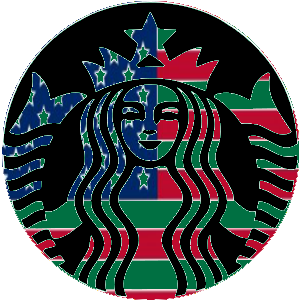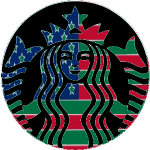Why do Americans love Starbucks so much?

Why do Americans love Starbucks so much?
A few months ago, 7-Eleven announced that they were taking over all Starbucks shops in Australia. Although a few people mentioned this to me at the time, it didn’t dawn on me then because the only thing I was paying attention to was basketball, and I almost forgot that Starbucks was in Australia.
Whereas Starbucks is on nearly every street – sometimes twice or more, as stand-alone stops as well as inside Barnes & Nobles and supermarkets – in my 3 years in Australia I’ve seen Starbucks once.
There are only 24 Starbucks in the whole of Australia, which was about the number of Starbucks I might see each day when I drove to work in Denver.
It failed miserably in Australia because of the taste of its coffee. However, it is still so popular in the United States, and, as Americans are wont to do, anything that is popular in the U.S. is forced upon the rest of the world.
Starbucks – a bastion of calm in a world of chaos
Whereas Australians gag at the thought of the taste of Starbucks coffee, Americans salivate when they walk through the glass doors of the chain, step on the cold grey tiles, slippery from dirt and mud of hundreds of patrons.
Americans are in a comfort zone when they look around at the darkened room of black merchandise display shelves with days-old and frozen pre-packaged sandwiches, which are next to CDs of trendy alternative bands that lovers of indie music think are too untalented.
Americans think it is a peaceful harmony listening to the constant dinging of the bell that acknowledges the front door has been opening and closing, which is louder than the 1950s revving car engine sounds humming from the six-foot wide and four-foot tall coffee machines stationed next to the two chiming cash registers.
Finally, familiarity, nostalgia and calmness overcome Americans when they take a whiff of the dirty rain wafting from the overcoat of the person standing in front of them in line.
Americans love their Starbucks because the atmosphere of a Starbucks coffee shop smells, looks, sounds, feels and tastes much better than McDonald’s, the other major competitor for the caffeine-craving on-the-go American, or the “free”-WiFi-seeking student unfamiliar with the concept that the nearby library provides the same service without requiring a $5 donation to corporate pockets.
 Starbucks – the place to go
Starbucks – the place to go
In most of Australia, if you want to meet people for a chat, you can go to the beach. If you live in Melbourne, where I do, where the locals think that anything under 20 degrees is “freezing” and a day without rain or the possibility of rain is less likely than giant robots fighting each other – oh, and where there is no worthwhile beach on which to do beach things and to avoid annoying backpackers – Melbournians meet each other at cafes.
Cafes in Melbourne try to be unique by serving the latest in trendy sandwiches and eggs, grab the dingiest metal chairs from the closest garage sale, do the least amount of sanding on a tree and use that for a table, and scour antique shops for the most rustic looking light fixtures. This careful planning makes each cafe dissimilar enough, especially compared with the cookie-cutter chains popular in the United States, that meeting a friend for a chat, a drink and often a meal is a slightly interesting experience.
In the United States, there is no cafe culture. There were diners in 1970s television shows about the 1950s, and there were supposedly dirty alleys in the 1980s, but the clean era of the 1990s were ripe for places with over-padded chairs and mini-tables – and that’s where Starbucks came in.
Starbucks – better than the pub
Because Starbucks were open during the day, and there was no age requirement, high school students on open campuses would flood the chain stores conveniently located across the street before school, during open periods and after school.
With the onset of the Internet in the 2000s, a population of shy, quiet, unambitious and unimaginative daters arose and had an inexpensive place to meet people that made their boring lives look less boring in comparison to the setting. (Author’s note: Before I came to Australia, Starbucks was my go-to Internet dating locale; when I came to Australia, and I stopped going on coffee dates, I impressed my now-wife.)
Starbucks – where everything is “grande”
Americans love everything in large sizes, and Starbucks manipulated this inherent American desire. Instead of “small”, “medium” and “large” sizes, Starbucks called everything large, except its largest size at the time (“venti”), as Paul Rudd noted and the whole country agreed. Only recently did Starbucks employees unofficially let people order a “small” or “medium” rather than “grande” or “tall”.
Coincidentally, McDonald’s around the same time removed its “medium” sizes and only served small, large and “supersize” – however, unlike Starbucks, McDonald’s just removed the medium items and added the larger size rather than just renaming things.
Everything in Starbucks is grande – from the overbearing green witch that hangs over the store entrance, who also hangs from a pole 35 feet high so that it can be seen from the next neighborhood, to the coffee machines with large decorative tubes at the top that were taken from a few tubas that were merged, to the chairs that are deep enough for three-quarters of my legs and whose arms are wider than my bottom.
Starbucks – winning over Americans since the 1990s
Starbucks made coffee machines look too fiddly, expensive and large, which meant that people wouldn’t buy them and have them at home. They made coffee interesting, different and trendy. They made the experience of going to Starbucks eventful. They appealed to Americans’ sweet tooth and need for quantity over quality. They filled the need for a drive-thru or fast food experience without the guilt of going to McDonald’s.
In short, they made bad coffee incredibly popular, even though it tasted terrible.
Recent Comments